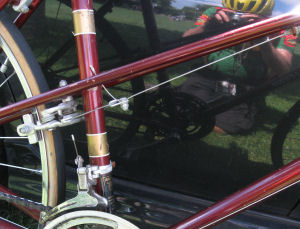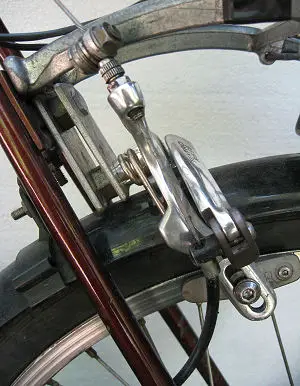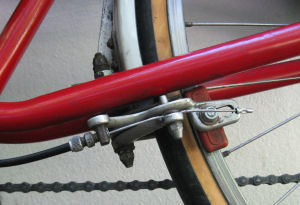How To Install Bicycle Brakes
Reports of the demise of this Spider web site are greatly exaggerated! We at sheldonbrown.com thank Harris Cyclery for its support over the years. Harris Cyclery has closed, just we keep going. Keep visiting the site for new and updated articles, and news almost possible new affilations.

If you are interested in advertising on this site delight go to SheldonBrown Ads.
- About Rim Brakes
- Calipers/cantilevers
- Caliper-restriction subtypes
- Attain
- Mounting
- Recessed
- Special Mounting Options
About Rim Brakes
- Why Rim Brakes?
- Rim Brake Types
- Centering
- Mechanical Advantage
- Noises/Squealing
- Shoe Types
- Shoe Adjustment
Near brake problems result from excessive friction or poor installation of the cables, not poor setup, or poor quality brakes. Also see the commodity on cables for information on cable option and aligning of brake cables and brake levers.
Calipers vs. Brakes with brazed-on fittings
Cycle rim brakes dissever into ii basic types: cantilever and caliper. Only to recap:
Caliper brakes are self-contained mechanisms, attached to the bicycle'due south frame by a single commodities for each restriction, front or rear. The arms reach down from higher up the tire, and need to be long plenty to get around the tire.
Brakes with brazed-on fittings attach to the sides of a wheel'south frame/fork, separately on each side. They crave special brazed-on (or welded) fittings on the frame. The brake for each bicycle consists of two separate arms, each of which is individually attached to the frame or fork. Run across the article on brakes with brazed-on fittings if that is the kind of brake you need to work on.
Types of Caliper Brakes
In that location are three mutual sub-types of caliper brakes:
|
Single-Pivot SidepullsBoth brake arms pivot effectually the centerbolt that attaches the brake to the frame or fork. The cable housing attaches to i brake arm and the inner wire, to the other. Unmarried-pivot brakes have very little (downward) move of the brake shoes as they wear, and rail a warped rim well, merely centering tin can be an issue, considering each brake arm is retracted independently by a spring. |  |
|---|---|
|
Dual-Pivot SidepullsThe restriction cable housing attaches to one restriction arm and the inner wire, to the other. The mechanism is asymmetrical; one brake arm rotates around the centerbolt and the other, around a pin above the cycle on the side reverse the cablevision. A cam connects the restriction arms and then they motility by equal and opposite amounts. High mechanical advantage makes this type of brake desirable where achieve is long, if the restriction also is rigid. A dual-pivot sidepull centers peculiarly well, due to the cam connecting the brake arms. There may fifty-fifty exist a centering adjusting screw at the cam. If asked to runway a warped rim, the brake rotates around the centerbolt, tending to loosen information technology. The restriction arm on the side with the offset pivot migrates up toward the tire as it wears. |  |
|
CenterpullsEach brake arm rotates around a pin on its side of the bike, and to a higher place the rim. Both brake shoes drift upward toward the tire as they wear. Centerpulls were popular in the 1960s and 1970s and are at present somewhat pop for bicycles that crave a long restriction reach. These brakes utilise a transverse cablevision and crave a frame-or fork-mounted cable hanger, so are very similar to U brakes. Come across the commodity about U brakes for advice on cablevision installation and adjustment. |  |
Reach
Reach is the effective length of the arms of a caliper brake. This is measured from the centerline of the eye bolt diagonally down to the middle of the brake shoe. Reach is normally expressed as a range (allowing for the fact that the brake shoes are adjustable, typically x-fifteen mm).
Achieve dimensions can run anywhere from 39-108 mm. There has been a historical trend toward shorter-reach brakes, every bit newer bicycles, particularly racing-fashion road bikes, are designed for use with narrow tires and without clearance for fenders.
The reach required for a particular installation depends on the frame structure (how low the brake mounting holes are) and the rim diameter. Generally, shorter-attain brakes work better, due to the reduced potential for flex and the higher mechanical reward. Long-reach brakes must exist of peculiarly stout construction and have long arm extension between the pivot and to the cablevision zipper to overcome these issues. Cantilever brakes and disk brakes avoid these problems, though they take other problems.
 |  |
|---|---|
| This caliper has a attain range of 39-49 mm. As shown, with the brake shoe adjusted all the way upward, information technology measures 39 mm from the centre of the bolt to the centre of the brake pad. | This fork and rim combination call for a restriction caliper that can be adapted to provide a 45 mm reach. The caliper shown would fit. |
Some people refer to "short-accomplish" "normal-reach" and "long-reach" calipers, but this is a recipe for confusion, and such terminology should be avoided. As fashion has changed, the 47-57 mm size that used to be "normal" has become "long" and the longer-reach  calipers have go nearly extinct, aside from very long BMX calipers.
calipers have go nearly extinct, aside from very long BMX calipers.
Currently, "short-attain" calipers unremarkably offer a range of 39-49 mm. This has get the de-facto standard for "route" calipers, and can now be considered "normal", though it is likewise correct to call it "short."
If you lot demand a brake with longer reach, y'all tin effectively extend the attain past using a drop bolt. Long-reach dual-pivot and centerpull brakes also are made.
Many newer brakes have the reach dimension marked on the back. For instance, the Shimano 600 caliper shown has a 47 - 57 mm accomplish range.
Mounting Caliper brakes
Caliper brakes have a middle bolt 6 mm or one/iv" in diameter, which fits through a matching holes in the fork crown or brake bridge of the frame. Traditionally, these bolts have been long enough to beetle all the way through, to be secured by a normal hex nut and associated washers. When a rear brake mounts to a curved surface on the brake bridge, you must use radiused washers (equally shown in the photo below) to avoid crushing the restriction bridge. If the mounting surface of the front brake is not radiused to fit the fork crown, a washer with a larger radius may be needed to support the restriction and avoid unnecessary stress on the brake bolt. The fork crown is strong enough that it will not beat if the nut at the rear is attached using only a flat washer or lockwasher.
Secure mounting of the front restriction is very important. A loose front end brake will announce itself past rattling, only, unfortunately, some bicycles are already a symphony of rattles, and 1 more instrument may go unnoticed. If the brake comes off, the restriction rotates forwards with the wheel, and then snags in the spokes. The cable tightens and yanks the handlebar violently to one side. The cyclist is pitched forward and may also suffer intestinal injury from the handlebar.
The front end brake bolt or nut should have some kind of anti-rotation treatment, generally a nut with a nylon locking insert or an anti-rotation compound on the brake bolt. You may likewise use blue threadlock compound.
Recessed mounting
Almost newer skilful-quality bicycles that employ caliper brakes apply recessed mounting to save weight and for a more elegant appearance. Calipers intended for recessed mounting have much shorter center bolts, which do not extend all the style through the crown/bridge. Frames/forks designed for recessed mounting accept stepped holes...half-dozen mm in front, 8 mm at the dorsum. Instead of a conventional hex nut that takes a 10 mm wrench, a cylindrical nut is used, which is broached for a five mm Allen wrench.
 | |
|---|---|
| Recessed-Mount Rear Caliper Uses 5 mm Allen Wrench | Traditional Nutted Rear Caliper with 2 radiused washers; uses 10 mm wrench |
Considering the trend toward recessed mounting and toward curt achieve calipers happened simultaneously, near curt-reach calipers come set up for recessed mounting. Medium- and long-accomplish calipers ordinarily come with longer centerbolts for conventional mounting.
Mounting recessed-mounting calipers on older frames
Rear: Here are three options:
- Yous might mountain a rear brake for recessed mounting ahead of the seatstays, as long equally the back side of the brake bridge
can be safely drilled out. This is more likely to work with a single-pivot or dual-pivot restriction, due to the difficulty of routing the cable with a centerpull. Use an 8 mm or Us letter-size O drill bit. A 5/16"drill flake is slightly smaller, and you may have to ream the hole slightly. Radiused washers (as shown on the nutted-manner brake in the photo above) must exist used if the brake bridge has no apartment mounting surfaces. The washer that goes under the nut must exist drilled out, and and so must the brace of a luggage rack, if it attaches to the brake bolt. Remember to reverse the brake shoes if they are single-ended.
- Drilling out the brake span from the front is possible on most frames using a right-angle electrical drill: the seat tube would make it the way of a normal. drill. Even Dremel makes a correct-bending zipper.
- Front brakes for recessed mounting have bolts that are long plenty to employ them as rear brakes, if you substitute the appropriate washers and a vi mm nut.
Front: Here are 3 options:
- Drill out the back of the fork crown, only as is described above for the rear brake.
That'south information technology if you tin get two front calipers. Sometimes, you may accept to deal with a pair of brakes, with one long and i short bolt. If you used the long one in dorsum, you can employ the short ane in front two different ways:
- Drill out the back of the fork crown and utilise an actress-long recessed nut. These nuts are unremarkably available for utilise in carbon-fiber forks.
- Use the short recessed nut, but don't put it through the back of the fork. Instead, push it up into the inside of the steerer from the bottom. You can achieve a 5 mm Allen wrench in through the hole in the back of the fork, and poke the curt caliper bolt in from the front end.
You may need to shorten the recessed nut slightly to get it to fit inside your steerer.
[That's Sheldon's suggestion -- I can't figure how this option would secure the brake adequately against the tendency of braking to rotate the shoes forward.-- John Allen]
Special restriction-mounting options
Rear Brake Ahead of the Seatstays
It is well-nigh common to install a rear caliper restriction backside the seatstays, but a luggage rack may interfere with the restriction, or its cable. A brake installation ahead of the seatstays is neater!
Bicycle frames designed for nutted brake bolts don't care which way you lot install a nutted brake. As already described, a rear brake intended for recessed mounting may be installed alee of the seatstays subsequently drilling out the dorsum of the brake bridge, the radiused washer, and the rack brace, if whatever.
To mount a brake alee of the seatstays on a frame designed for recessed mounting, yous may utilize a front brake made for recessed mounting, or a rear brake made for nut-type mounting.
A centerpull brake mounted this mode will have a slightly odd cable pull and will piece of work all-time on a alpine frame.
Rear Restriction at Mixte Stays

Cable routing from underneath

Older sidepull brakes conveniently allow you to switch the positions of the the anchor commodities and adjusting butt. Many newer brakes have the adjusting barrel threaded directly into the upper brake arm. With these brakes, a commodities-on cablevision finish can nonetheless be installed to replace the ballast bolt at the lower restriction arm. Equally shown, the cable is threaded through the adjusting barrel at the upper brake arm, and then secured with a 2d anchor bolt. This installation is inelegant merely information technology works. Perhaps someday, someone volition offering an anchor bolt assembly that threads into the upper restriction arm...The installation shown, on a Raleigh Twenty bicycle, as well uses a dwelling house-fabricated drib bolt.
With a centerpull brake, it is possible to route the cable from underneath past attaching a barrel adjuster to the yoke. The inner wire needs to exist secured past an anchor bolt in the seat cluster expanse. This may conveniently be attached to a seatstay cable cease assembly, replacing a quick-release mechanism.
With a cable routing from underneath, rainwater tin slide down the cablevision into the housing, and accrue. In wintertime, information technology can freeze and disable the brake. For solutions to this problem, run into communication in the commodity about cables.
Routing the cable from underneath to the cable stop at the peak of the head tube may be desirable on a front centerpull or cantilever brake on a folding bicycle and then that there is enough cablevision to let the handlebar and stem to exist lifted off and laid aslope the frame. The cable housing is attached to the yoke. In this case, inverted cable attachment to drib-bar brake levers besides can be 
Rear Brake at the Chainstays
The rear brake is unremarkably mounted at the chainstays on folding bicycles and recumbents where cable routing to a brake at the seatstays would be inconvenient, or if there are no seatstays. A disadvantage of this location is that the restriction is more exposed to clay.
- What's New
- Sheldon Brown on Facebook
- Site Feedback & Questions
Articles by Sheldon Brown and Others
- What'southward New
- Beginners
- Bicycle Glossary
- Brakes
- Commuting
- Cyclecomputers
- Do-It-Yourself
- Essays and Fiction
- Family Cycling
- Fixed-Gear
- Frames
- Gears and Drivetrains
- Humor
- Former Bikes
- Repair Tips
- Singlespeed
- Tandems
- Touring
- Video
- Wheels
- Translations
- Sheldon - the man
Reports of the demise of this Web site are greatly exaggerated! We at sheldonbrown.com thank Harris Cyclery for its back up over the years. Harris Cyclery has airtight, but nosotros keep going. Go on visiting the site for new and updated manufactures, and news about possible new affilations.
Copyright © 1997, 2008 Sheldon Dark-brown
Harris Cyclery Domicile Folio
If yous would like to make a link or bookmark to this page, the URL is:
http://world wide web.sheldonbrown.com/calipers.html
Last Updated: by John Allen
Source: https://www.sheldonbrown.com/calipers.html
Posted by: williamsmothas.blogspot.com


0 Response to "How To Install Bicycle Brakes"
Post a Comment